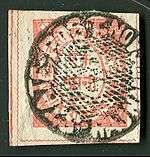Nandgaon State
| Nandgaon State नांदगाँव रियासत | |||||
| Princely State of British India | |||||
| |||||
|
Flag | |||||
 | |||||
| History | |||||
| • | Established | 1833 | |||
| • | Accession to the Indian Union | 1948 | |||
| Area | |||||
| • | 1901 | 2,256 km2 (871 sq mi) | |||
| Population | |||||
| • | 1901 | 126,365 | |||
| Density | 56 /km2 (145.1 /sq mi) | ||||
| Today part of | Rajnandgaon district, Chhattisgarh | ||||
| Arnold Wright ed., Indian States: A Biographical, Historical, and Administrative Survey, Page 812 | |||||

Nandgaon State (Hindi: नांदगाँव), also known as Raj Nandgaon, was one of the princely states of India during the period of the British Raj. Nandgaon town, in present-day Rajnandgaon District of Chhattisgarh, was the only town of the state and the see of the ruler's residence.[1]
The first ruler Ghasi Das Mahant, was recognized as a feudal chief by the British government in 1865 and was granted a sanad of adoption. Later the British conferred the title of raja on the ruling mahant.[2][3]
History
Historical background
The foundation of the estate of Nandgaon hails back to Prahlad Das, a shawl merchant who in the 18th century had migrated from the Punjab region. When he settled in Ratanpur the area was ruled by the Bhonsle clan of Marathas.
Prahlad Das belonged the Bairagi sect whose members practised strict celibacy. The word 'Bairagi' is derived from the Sanskrit Vairāgya, meaning 'freedom from passions'. Succession was ensured by chosen disciples, Chela, who became Mahants and inherited all the possessions of their predecessor. Prahlad Das became wealthy and after his death his disciple Hari Das was given power and influence by the local Maratha ruler who promoted him as his spiritual advisor. After about a century the Mahants had acquired the four parganas of Nandgaon, Pandadah, Mohgaon and Dongargaon, former feudatory estates of the Raja of Nagpur.
Princely State
Nandgaon State proper was founded in 1865 when the four feudatory parganas ruled by the Bairagi Mahants were merged and recognized as a princely state. The vow of celibacy of the rulers lasted until 1879, when the seventh Mahant, Ghasi Das, who had married and had a son, was recognized by the British government as an hereditary ruler. Most of the inhabitants of the state were Gonds, Telis, Chamars and Ahirs distributed in 515 small villages in the area.[4] Nandgaon State's last ruler signed the accession to the Indian Union on 1 January 1948.[5]
Rulers
The rulers of the princely state of Nandgaon bore the title of 'Mahant'.[6]
Mahants
- 1865 - Nov 1883 Ghasi Das (b. 1820 - d. 1883)
- 1883 - 1897 Balram Das (b. 1866 - d. 1897) (personal style Raja Bahadur from 2 Jan 1893)
- 1897 - 25 May 1912 Rajendra Das (d. 1912)
- 24 Jun 1913 - 1940 Sarveshvara Das (b. 1906 - d. ....)
- 18 Sep 1940 - 15 Aug 1947 Digvijai Das (b. 1933 - d. 1958)
See also
References
- ↑
 This article incorporates text from a publication now in the public domain: Chisholm, Hugh, ed. (1911). "article name needed". Encyclopædia Britannica (11th ed.). Cambridge University Press.
This article incorporates text from a publication now in the public domain: Chisholm, Hugh, ed. (1911). "article name needed". Encyclopædia Britannica (11th ed.). Cambridge University Press. - ↑ Chhattisgarh ki Riyaste/Princely stastes aur Jamindariyaa. Raipur: Vaibhav Prakashan. ISBN 81-89244-96-5.
- ↑ Chhattisgarh ki Janjaatiyaa/Tribes aur Jatiyaa/Castes. Delhi: Mansi publication. ISBN 978-81-89559-32-8.
- ↑ The Tribes and Castes of the Central Provinces of India
- ↑ Nandgaon Princely State
- ↑ Princely States of India
External links
Coordinates: 21°06′N 81°02′E / 21.10°N 81.03°E
